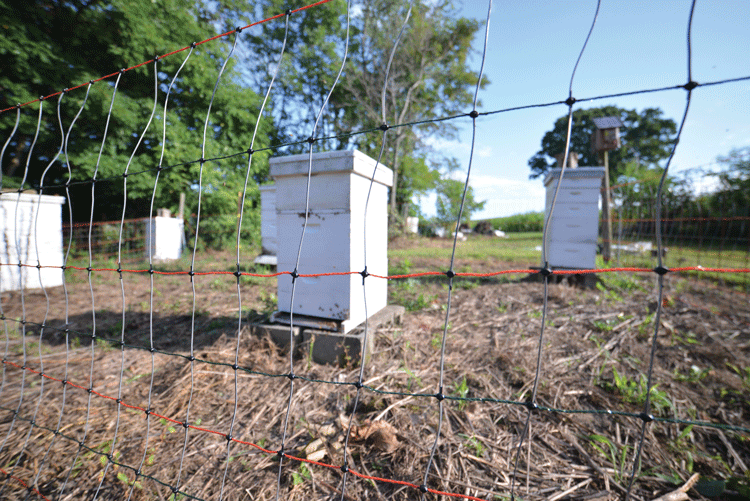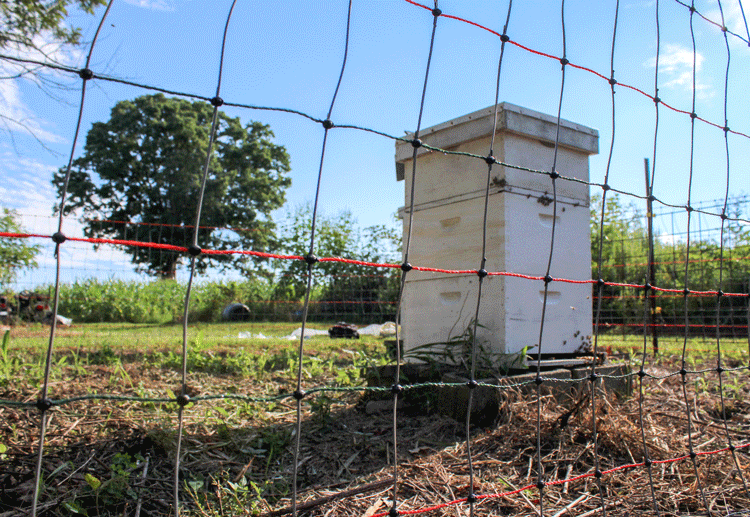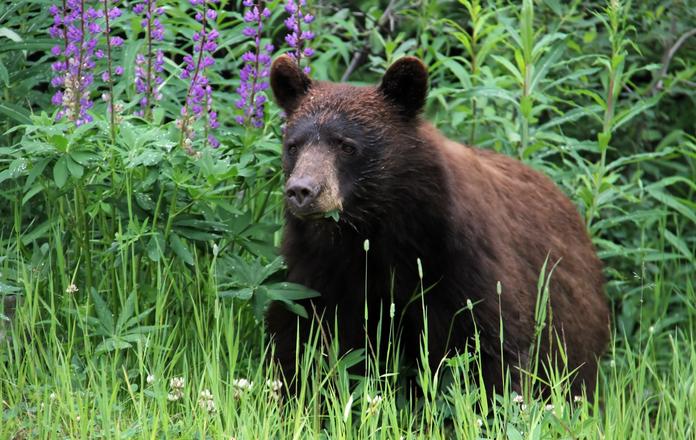Bears have a very big sweet tooth and quickly cause devastation to a well-earned apiary. They are very smart animals with a long memory of a good meal. These traits require the need for a psychological barrier to block bears from devastating the bees, hives, honey, and your hard-earned efforts and money. The use of an electric fence will serve its purpose to protect your efforts for many years when properly constructed and maintained.
Electric Netting

These nets stand 40 inches tall and are 50’ long to provide a positive/negative barrier to keep bears and other predators out. It is constructed with 12 horizontal lines of stainless-steel conductors with 5 double-spiked step-in posts included. Drooping is prevented by the semi-rigid vertical stays 7” apart between the posts. If the net is placed in an area with low vegetation growth, electrical shorts are prevented by a non-conductive bottom horizontal strand. Electric netting has many benefits that make it an ideal fence to protect precious beehives and is proudly manufactured in the USA!
User-Friendly
Production of these nets keep the user in mind making them easy to install. One person can install an electric net in ten minutes or less by unrolling the net along the desired fence line. Simply step each of the posts into the ground and tie the end post together. Add electricity!
These nets are also made to connect together for larger areas!
Portable
If you decide to move your hives, simply pull the posts out of the ground and roll up the net! The nets are also easy to store away when not in use thanks to its bundle design.
Versatility
While the nets serves a great purpose protecting your bees, it can also be used for many other species or applications. If you were decide to remove a few hives and have too much fence, use it for other animals or your garden to protect from predators.
Sturdy
As mentioned above, the fence is constructed with semi-rigid vertical stays spaced 7 inches apart. This keeps the net from sagging and shorting out. The nets also utilize stainless-steel conductors on the horizontal stays instead of copper or aluminum. These conductors provide superior tensile strength, are rust resistant, and permanence over copper and aluminum conductors keeping the current flowing through the net. Tiebacks can be used at the corners for extra strength.
Electrification
Electrifying these nets are as easy as installing and requires little time and few components. A minimum of 0.15 output joule energizer should be used per net. If you are connecting nets to make a longer fence, simply multiply by the number of nets! A low-impedance battery or mains energizer is suitable for powering the nets.
High Tensile

The electric fence for this situation should be installed on a plot of land free of vegetation, such as a mulch bed. This will ensure there is not high grasses or tree limbs that could cause the fence to short. The fence should be installed early in the honey season to make sure the bear gets a negative welcome before the sweet taste of honey is available. It is much easier to keep bears away if they have not had the chance to taste what is on the other side of the fence.
We recommend the following fence construction:
- Minimum of 6 strands of 12 ½ gauge high tensile galvanized wire.
Provides a high breaking strength and rust resistance for 40 years. - Wire tension 125 pounds.
- Post no more than 10 feet apart, set 2 feet into the ground
Wood, metal, plastic, fiberglass, or composite posts work well. - Bottom wire strand should be 2 inches off the ground.
Helps prevents predators from attempting to go under the fence. - Remaining strands should be placed 6-8 inches apart using insulators on hot strands.
- Create a positive-negative system to ensure the bear still receives a shock even in very dry conditions.
The first, third and fifth strands are connected to the positive terminal of the charger. The second, fourth, and sixth strands are connected to the ground wire connected to the ground bed of the charger. - Create a ground bed
Connect the negative terminal to multiple ground rods that are drove 3 feet into the ground in a moist area for best grounding. One ground rod per one joule of energizer is recommended. - The size of the energizer will depend on the length of the fence.
One joule of output for each mile of fence. - Be sure to place your energizer in an enclosure to prevent damage from weather and angry bears.

No matter which system you choose, the quicker you can introduce the electric to the bear, the better. Bears have poor eyesight, but a keen sense of smell, therefore putting bait on the fence is a common practice. Baiting the fence is as simple putting a piece of bacon or tinfoil covered in peanut butter on the hot wires of the fence. The bear will directly touch the hot wire to get the food, resulting in a painful memory.
It is important to construct your fence with high quality products due to the brute strength the bear can impose on the fence, and also for minimal repair work. Design, quality, and proper upkeep with determine the effectiveness of any fence you build. Regular inspection of the fence will allow for a long lasting fence while catching weak points early for a quick repair.